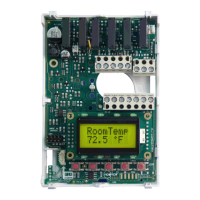Installation
• Remove security screw on the bottom of thermostat cover.
• Open up by pulling on the bottom side of thermostat.
• Remove Assembly and remove wiring terminals from sticker. (Fig. 3)
• Please note the FCC ID and IC label installed in the cover upon removal of cover
for the wireless products.
A) Location:
1- Should not be installed on an outside wall.
2- Must be installed away from any heat source.
3- Should not be installed near an air discharge grill.
4- Should not be affected by direct sun radiation.
5- Nothing must restrain vertical air circulation to the thermostat.
B) Installation:
1- Swing open the thermostat PCB to the left by pressing the PCB locking tabs.
(Fig. 4)
2- Pull out cables 6” out of the wall.
3- Wall surface must be flat and clean.
4- Insert cable in the central hole of the base.
5- Align the base and mark the location of the two mounting holes on the wall.
Install proper side of base up.
6- Install anchors in the wall.
7- Insert screws in mounting holes on each side of the base.
(Fig. 4)
8- Gently swing back the circuit board on the base and push on it until the tabs lock
it.
10- Strip each wire 1/4 inch.
11- Insert each wire according to wiring diagram.
13- Gently push back into hole excess wring (Fig. 5)
14- Re-Install wiring terminals in correct location. (Fig. 5)
15- Reinstall the cover (top side first) and gently push back extra wire length into the
hole in the wall.
16- Install security screw.
• If replacing an old thermostat, label the wires before removal of
the old thermostat.
• Electronic controls are static sensitive devices. Discharge
yourself properly before manipulation and installing the
thermostat.
• Short circuit or wrong wiring may permanently damage the
thermostat or the equipment.
• Anti-short cycling can be set to 0 minutes for equipment that
posses their own anti cycling timer. Do not use that value
unless the equipment is equipped with such internal timer.
Failure to do so can damage the equipment.
• All Allure communicating thermostats are to be used only as
operating controls. Whenever a control failure could lead to
personal injury and/or loss of property, it becomes the
responsibility of the user to add safety devices and/or alarm
system to protect against such catastrophic failures.
Location of PCB retaining tabs
Re-install terminal blocks
Thermostat assembly

